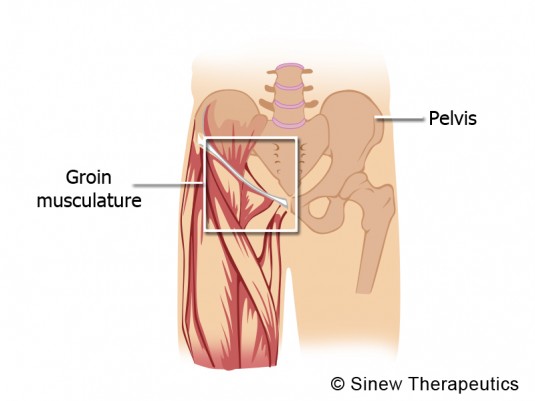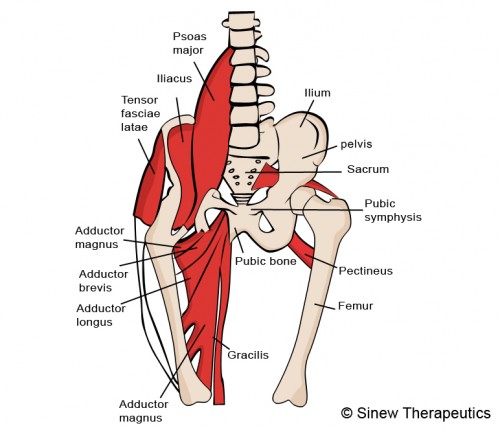Inflammation of the adductor muscle group ( inner groin muscles) is a common occurrence in many sport-related activities. In fact, according to disability data, groin injuries account for two to five percent of all sports injuries.


Inflammation of Groin Adductor Muscles
What Is Inflammation?
To understand the importance of inflammation of the adductor group, one must first understand what inflammation is. Many confuse inflammation and swelling to be the same thing. However, swelling is the generalized or localized enlargement or protuberance of a body part or area and is only one of five cardinal signs of inflammation. Swelling, pain, heat or warmth, redness, and loss of function are the cardinal signs of inflammation. Acute inflammation is the basic biological response by the body when it perceives an injury or pathogen. Damaged tissues send biochemical distress signals and plasma, leukocytes, and special cells flood the area from the bloodstream to start the healing process. This is called the inflammatory response, and while it is the first line of defense after injury, it must be careful controlled. If the inflammatory process is unchecked, it can actually create more damage and destroy healthy tissues.
Anatomy As It Relates To Adductor Muscle Inflammation
There are five short and long adductor muscles - the pectineus, adductor brevis, and adductor longus are the short adductors and the gracilis and adductor magnus are the long adductors. The long adductors span from the pelvis to the knee, while the short adductors span from the pelvis to the thighbone. The main function of the muscle group is to pull each leg together. A kicking motion, for example, would be accomplished partly by the adductor muscle group; after the leg is extended by the quadriceps muscles, the adductor muscles pull the inner thigh back to the midline of the body. Another example of adductor muscle use would be squeezing an object between the legs.
What Causes Adductor Muscle Inflammation?
Inflammation to one or more of the adductor muscles is the first sign of injury or irritation. This is most often due to a muscle strain (also called a pulled groin) that involves stretching or tearing of the muscle tissue from a direct trauma; the muscle meeting an unexpected opposing force during its normal motion, such as a football kick being blocked; overuse; or repetitive stress. Movements, activities, and sports like running, especially sprinting; kicking; hurdling; dancing; jumping; soccer; horseback riding; football; yoga; and karate all highly rely upon the adductor muscles.
Keep in mind that if an injury isn’t noted, certain autoimmune disease processes, such as multiple sclerosis or lupus, may also produce an inflammatory process in the muscles.
Inflammation may also be present in the initial stages of Prussian's disease (myositis ossificans), which is the calcification of muscle.
What Are The Symptoms Of Inflammation Of The Adductor Muscles?
* localized swelling, redness, heat, loss of motion, and/or pain
* the affected muscle(s) may be tender to touch
* difficulty performing adduction movements
* pain may be mild to severe
* pain in the groin
* pain may radiate from the groin down the leg
* pain when the legs are pushed together
Strengthening Exercises
These Groin Exercises are ideal to build strength and flexibility.
Massage Treatment
These Groin Massage Techniques are of great value in pain relief; circulation stimulation; dispersing blood and fluid accumulations; swelling reduction; and relaxing muscle spasms, especially when used alongside the Sinew Therapeutics liniments and soaks.
ACUTE STAGE SYMPTOMS AND TREATMENT
This stage is characterized by swelling, redness, pain, and possibly a local sensation of heat, indicating inflammation. If coolness makes your pain feel better, then the Acute Stage Treatment is recommended.
ACUTE STAGE SYMPTOMS:
The acute stage starts the moment an injury occurs and lasts until the swelling and inflammation are gone. The swelling is the result of the blockage of blood, tissue fluids and circulation in the groin because their normal movement has been disrupted by the force of the injury. Just like cars back up behind a traffic jam, causing congestion, exhaust and overheating; blood and fluids back up behind the injured groin, causing pain, inflammation, lumps and swelling.
The sensation of heat is due to the warming action of the blood and fluids overheating in the injured groin as they back up and accumulate. Stiffness and decreased mobility are due to spasms in tendons and ligaments that have contracted reflexively beyond their normal range from the impact of the injury.
As ligaments and tendons stretch and tear, blood from ruptured blood vessels becomes trapped in the local tissues. As the trapped blood clots up, it sticks the tissues together creating adhesions. Adhesions cause pain, inflammation and restricted movement because the layers of tissue that used to slide smoothly across one another now adhere and snap which interferes with normal functioning. It is essential to break up clotted blood as quickly as possible to prevent adhesions and scar tissue from forming.
During the acute stage it is very important to restore normal circulation to the groin, break up clotted blood and stagnant fluids, reduce swelling, and reduce the redness and heat associated with inflammation. By restoring the flow of blood, fluids, and circulation in the groin, then pain is relieved, damaged tissues can regenerate with healthy functional tissue, and the groin can strengthen and regain it's mobility.
ACUTE STAGE TREATMENT:
1. Apply the Sinew Herbal Ice on your groin to reduce redness, swelling, and inflammation while dispersing accumulated blood and fluids to help restore normal circulation to the groin. This first-aid treatment is used in place of ice to significantly speed up the healing process. It reduces the swelling and inflammation more effectively than ice, allowing you to more quickly regain range of motion. Acute Sinew Liniment can be used in-between applications.
Ice is not recommended because it does not help repair damaged tissues and keeps everything in the injured area frozen, causing the stagnation of blood and fluids and the contraction of muscles, tendons and ligaments. In Chinese sports medicine ice is not used and is considered a culprit in injuries that donít heal well.
2. Massage your groin with Acute Sinew Liniment to relieve pain, reduce swelling and inflammation, break up clotted blood and stagnant fluids, and stimulate circulation of blood and fluids to help cells quickly repair damaged tissues. Sinew Herbal Ice can be used in-between applications.
3. The Sinew Sports Massage Oil is recommended for use before and after exercise, sports and strenuous activity. It warms and stimulates your muscles, increases circulation and relieves tightness, hence improving your performance and helping to prevent injury.
CHRONIC STAGE SYMPTOMS AND TREATMENT
This stage begins once the swelling and inflammation are gone, but you still feel pain, stiffness, weakness, and/or sensitivity in cold and damp weather. If heat makes your pain feel better, then the Chronic Stage Treatment is recommended.
CHRONIC STAGE SYMPTOMS:
The chronic stage begins once the swelling and inflammation are gone, but you still feel aching pain and stiffness. This is because there are still accumulations of stagnant blood and fluids in your groin that are blocking circulation and blood supply to damaged tissues, creating residual pain, stiffness and weakness. You may actually feel hard nodules like sand in the tissue, indicating accumulation, calcification, and adhesions, which all cause pain, stiffness, and joint instability.
Your groin may feel more sensitive to the cold and ache in cold and damp weather due to impaired circulation. These symptoms are often the result of failure to treat the injury properly from the outset and overicing.
Increasing circulation and blood supply to the damaged tissues is very important in treating chronic injuries because tendons and ligaments do not have an extensive direct supply of blood. That is why chronic injuries can be slow to heal. Increasing local circulation also prevents cold and dampness from penetrating the injured area, preventing pain and stiffness.
During the chronic stage it is very important to break up remaining accumulations of blood and fluids, and increase circulation and blood supply to the damaged tissues. By increasing circulation and blood flow in the groin, then pain and stiffness is relieved, and the damaged tissues can strengthen to restore stability.
CHRONIC STAGE TREATMENT:
1. Massage your groin with Chronic Sinew Liniment to relieve pain and stiffness, strongly stimulate circulation and blood flow to damaged tissues, and promote the healing of overstretched tendons and ligaments. The Sinew Relaxing Soak can be used in-between applications.
2. Soak your groin with the Sinew Relaxing Soak to relax muscles and tendons that are in spasm, ease joint pain and stiffness, and improve range of motion. The Sinew Relaxing Soak is particularly useful if you feel spasms in your groin. The soak can be used by saturating a towel in the liquid and applying it to your groin. Chronic Sinew Liniment can be used in-between applications.
3. The Sinew Sports Massage Oil is recommended for use before and after exercise, sports and strenuous activity. It warms and stimulates your muscles, increases circulation and relieves tightness, hence improving your performance and helping to prevent injury.







